The essence is this: I find myself with two 6×6 SLR systems from the 1970s. One of them was a staple of professional photography for half a century. The other was a rival that eventually faded away. 50 years on, there’s quite a gulf between them in reputation and price and this makes me really curious how they would compare head to head. The goal is not to name a winner or loser. I just want to understand how these two systems differ in use and images. After all, they were both designed for the professional market. I anticipate them to be pretty similar in image quality, with their differences coming through more vividly in handling.
How I got here
The Bronica S2a was my first 6×6 SLR. I’ve owned it for a few years and find it dependable and capable. It’s been serviced and has an updated BrightScreen and the late model standard lens, the Nikkor H.C. 75mm f2.8. It’s fully mechanical, aesthetically beautiful, and in perfect working condition. But it’s also heavy. A real chonk of a camera. Awkward on a neck strap. So when I saw my local shop selling a very reasonably priced Hasselblad 500c/m, I decided to “trade up.”
It wasn’t that I was so unhappy with the S2a. I’ve just always had a romance for the Hasselblad 500 series. Besides their reputation and besides that they went to the moon, it was the camera that my step-father used for many years. He traded his kits off in the early 2000s when folks were switching to digital and I’ve always regretted that those cameras are gone now, scattered to the winds. So seeing one at a good price when I had some cash to spend, I had to scoop it up. It seemed unnecessary to own two 6×6 systems though, so I reluctantly put my Bronica kit up on Ebay and shipped it to its new home.
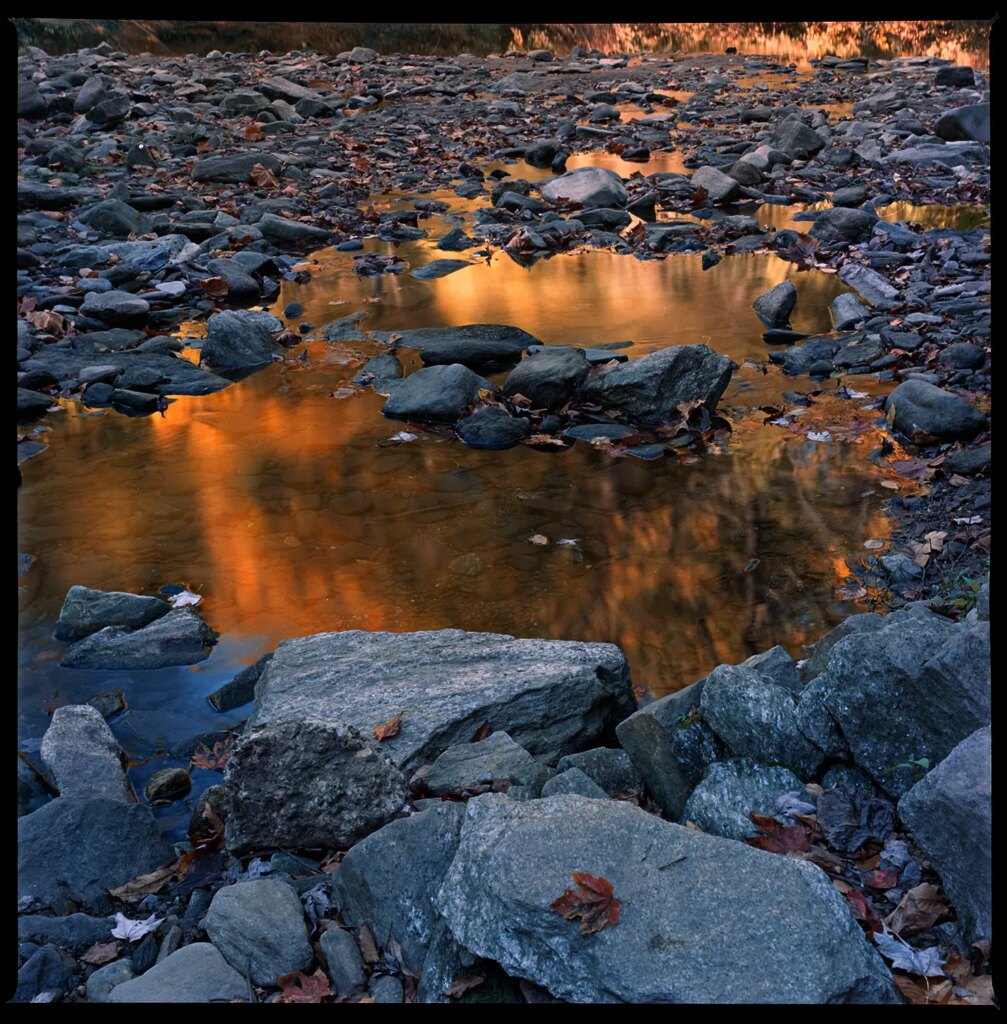
Lens: Nikkor H.C. 75mm f2.8 with 8x ND filter
Film: Kodak Ektar
Settings: 4 seconds, f22
The H.C. 75mm was the last of three 75mm lenses that Nikon made for the S series, with the prior two being the P and the P.C. I shot a comparison between the P (cheapest of the group) and the H.C. a few years back and found the P to have lower contrast and slightly different rendering, but overall quality was very similar, which is to say they were both excellent. Two other standard lenses with good reputations are an 80mm f2.4 Zenzanon and an 80mm f2.8 made by Zeiss Jena, though both are very rare and tend to be pricey
Unfortunately, the buyer backed out while the camera was still in transit and the whole thing got pretty hairy. I was ultimately able to get the camera back, but it was an unpleasant enough experience to get me off Ebay for awhile. Feeling rattled, I stored it away until I could decide the best way to resell it.
Meanwhile, I’d been shooting with the 500c/m and really enjoying it. Though not much smaller, the design was very ergonomic and the images looked incredible. I could see why so many name this particular lens and camera combo as a masterpiece.
And so recently, while doing a bit of cleaning, I came across the still-boxed-up Bronica kit. I’ve shot a fair bit with both cameras at this point and I know how they differ in use, but I don’t know how they differ in final images. And I wonder if my experience with the Bronica will be different after getting used to the Hasselblad. I think many might find the comparison slanted, yet these two cameras could have been sold side-by-side through most of the 70s with their pricing much closer than it is today. So I unpacked my old S2a kit and set out for a day of head to head shooting.
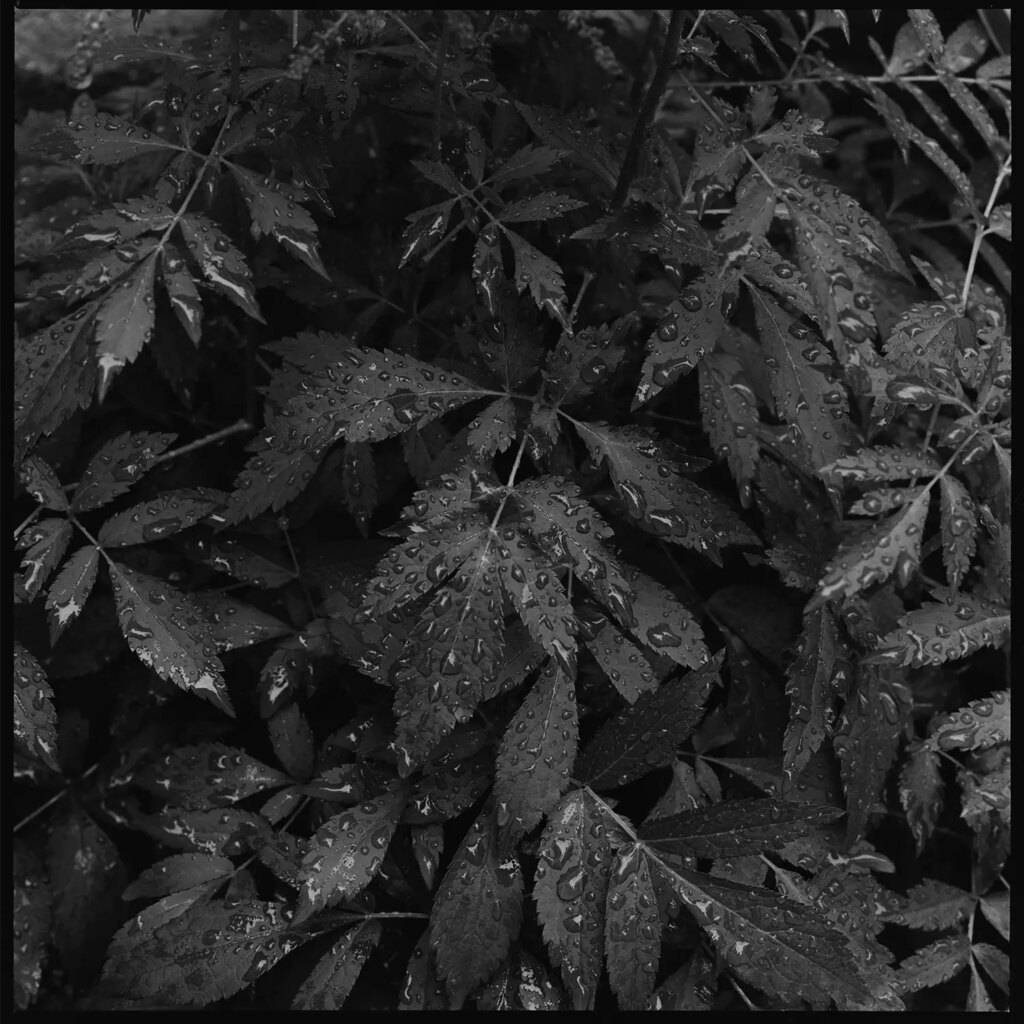
Lens: Zeiss Planar T* 80mm f2.8 C with 10mm extension tube
Film: Ilford Delta 100
Settings: 1/8th of a second, f22
Physical comparisons
Bronica S2a, 1969-1977
Weight (with film back, waist level finder, and 75mm f2.8 lens): 1939g or 4 lbs 4 oz
Full kit weight (with film back, waist level finder, 50mm f2.8, 75mm f2.8, 200mm f4): 2846g or 6 lbs 6 oz
Hasselblad 500c/m, 1970-1994
Weight (with film back, waist level finder, and 80mm f2.8 lens): 1491g or 3 lbs 5 oz
Full kit weight (with film back, waist level finder, 50mm f4, 80mm f2.8, 180mm f4): 3320g or 7 lbs 5 oz
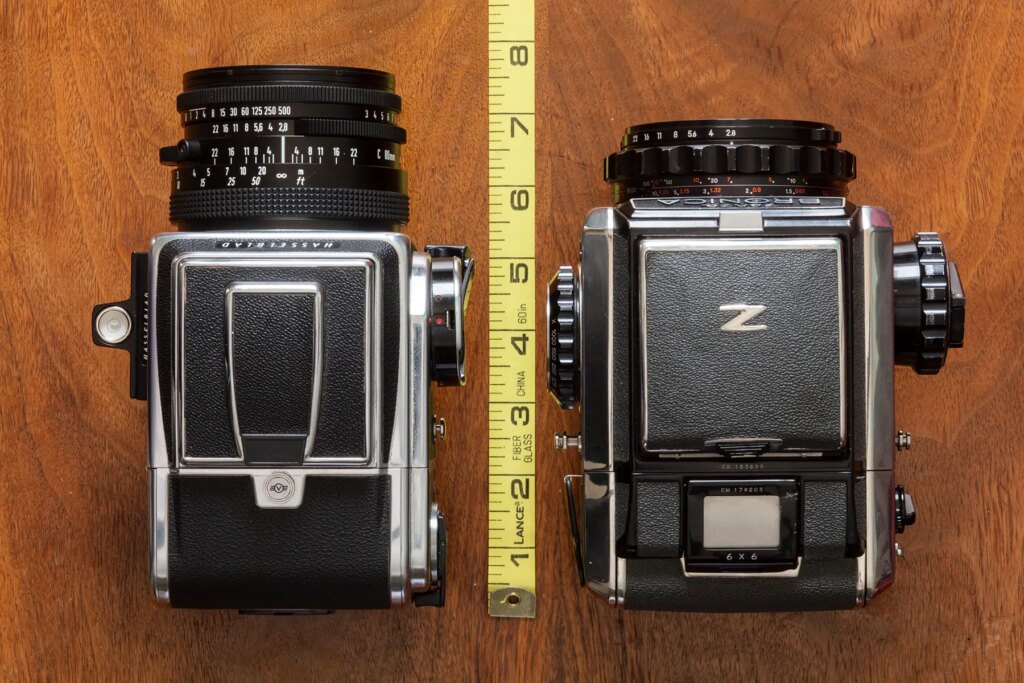
In Use
While the Bronica with 75mm lens is 33% heavier, the lenses are much lighter and somewhat smaller. This is because the focusing helicoid is in the body and the lenses are just the optical block and aperture mechanism. Depending on your kit, the Bronica might actually be lighter than the Hasselblad because of the smaller lenses. Also, because the Bronica body is heavier, it may offer more stability for hand-held shooting. I often shot the S2a hand-held without shake spoiling the photos. That said, the Hasselblad feels better in my hands. The lighter weight of the 500c/m body is more comfortable for a long day out, but I do find myself less inclined to bring additional lenses.
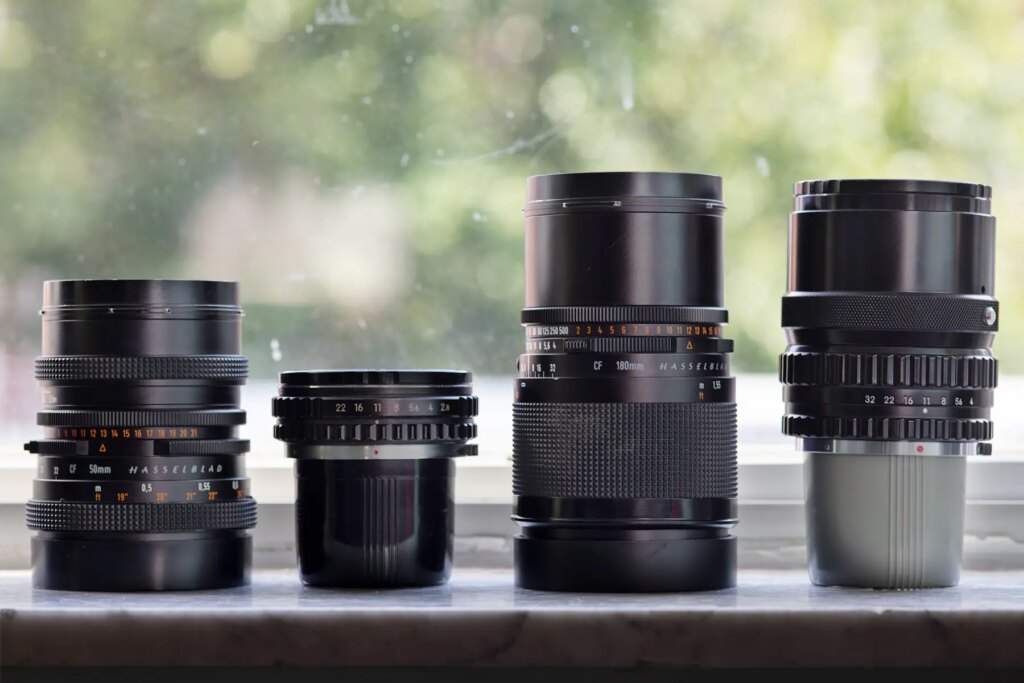
Similarities, broadly
Both cameras shoot 6×6 images on 120 roll film. Both cameras are single lens reflex style. Both cameras are modular, with changeable film backs, lenses, and viewfinders. Both cameras are 100% mechanical. Both cameras lock the shutter when the darkslide is inserted and lock the film back in place when the slide is removed.
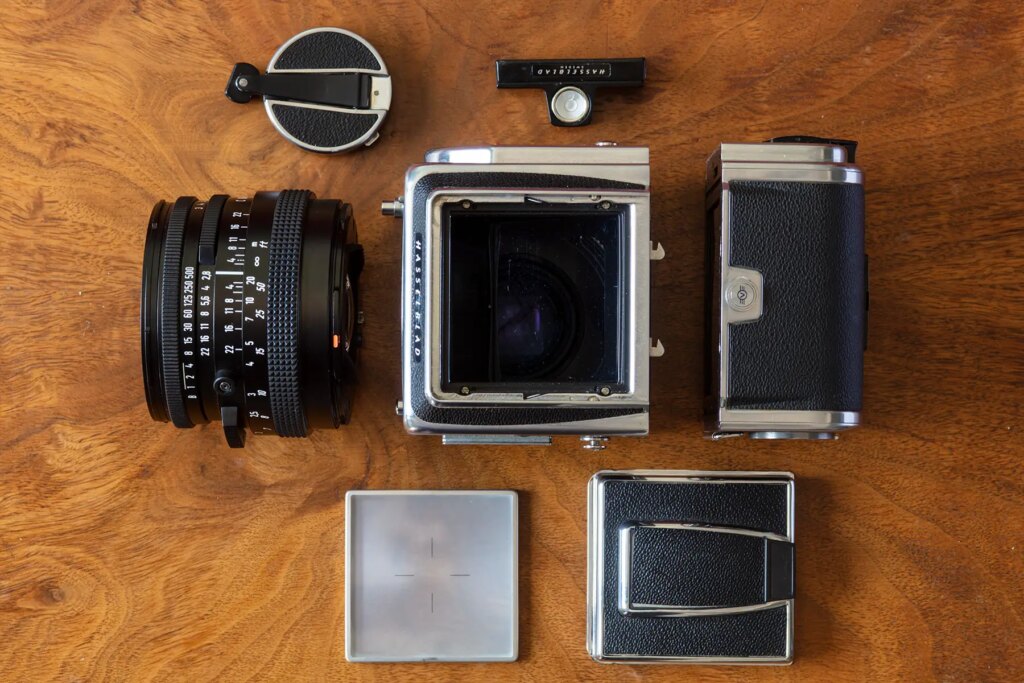
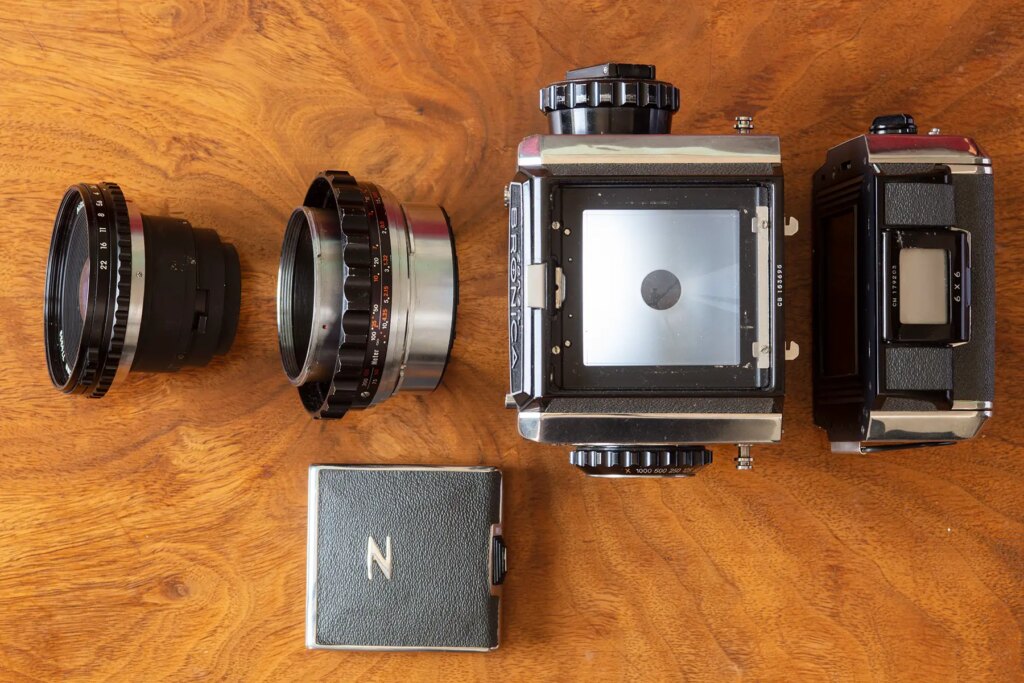
Bronica S2a features
The most noteworthy difference, from a practical point of view, is that the S2a is a focal plane shutter. This allows for a faster top speed of 1/1000th of a second vs the 500c/m’s 1/500 leaf shutter, though may also increase shutter vibration. The Bronica also has instant mirror return, unlike the Hasselblad which blacks out the finder until re-cocked. The other major difference is the body-mounted focusing helicoid. Focusing is just the same as any other lens, but the lenses are significantly smaller and lighter. There’s a quirk to this design though, and it’s that all lenses have the same amount of max extension. This means that shorter focal lengths can focus very close, but longer lenses have a poor minimum focal distance. Some very long lenses require a telephoto helicoid. Both my wide and normal S2a lenses focus several inches closer than their Zeiss counterparts. The helicoid is also threaded on the inside to accept an unusual m57 x1 sized mate. With some creatively applied adapters, this can be used to mount foreign lenses. For a time I was shooting a 150mm Rodagon enlarger lens with good results. Because of the shared helicoid, the distance scales for multiple focal lengths are all printed together which makes them difficult to read. All lenses have standard front threading for filters. That doesn’t seem like a special feature, but the Hasselblad used a proprietary bayonet which requires either dedicated filters or an adapter.
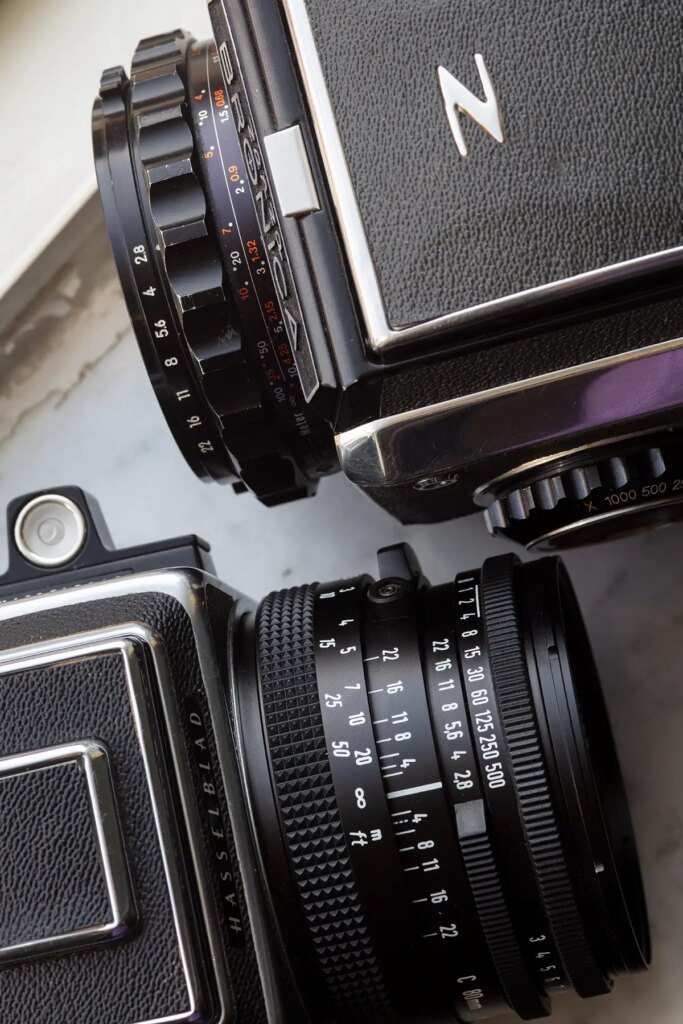
Other minor notes: Activating the magnifier on the waist level finder is done with a simple tap on the front of the hood. This is my favorite design of any WLF I’ve used as you don’t have to reach inside or look for a tiny release button. It’s so intuitive and simple. Also, if you twist the shutter release you can lock it. This seems redundant as the darkslide also locks the shutter, but I prefer to keep my darkslide out if I’m not bringing multiple backs and so a secondary shutter lock is useful. The film backs also allow either 120 or 220 rolls if 220 ever returns.
Hasselblad 500c/m features
If shooting with flash, the leaf shutter design allows sync up to the full 1/500 speed. The Bronica flash sync tops out at a sluggish 1/40th of a second. Also, the 500c/m has a mirror lock-up feature which, combined with the leaf shutters, a cable release, and a sturdy tripod, allows for completely vibration free firing at any speed. The lack of a mirror lock-up on the Bronica is one of my biggest issues with it as it makes certain speeds iffy with longer lenses even when tripod mounted. The 500c/m is also more modular, allowing quick easy changing of the focusing screen and winding knob. Possibly the best selling point for the Hasselblad though is that Zeiss continued making lenses decades after Nikon and Bronica had discontinued the S line. This means newer designs with more sophisticated optics and better coatings with (potentially) less miles on them. All eras of leness also have an EV indicator to help maintain consistent exposures when you change settings. I know some folks ignore it or find it annoying, but it so happens that I learned to meter by EV so I find it pretty wonderful. I mentioned that the lenses use a proprietary filter type which I dislike, but there is a benefit: adding or removing caps and filters is very fast and secure.
There’s also a feature that I like on the older C series lenses, which is the moving depth of field indicators. When you adjust the aperture, two red lines expand to show the depth of field change. It’s probably over complicated and doesn’t tell you anything a painted scale can’t, but I really enjoy it.
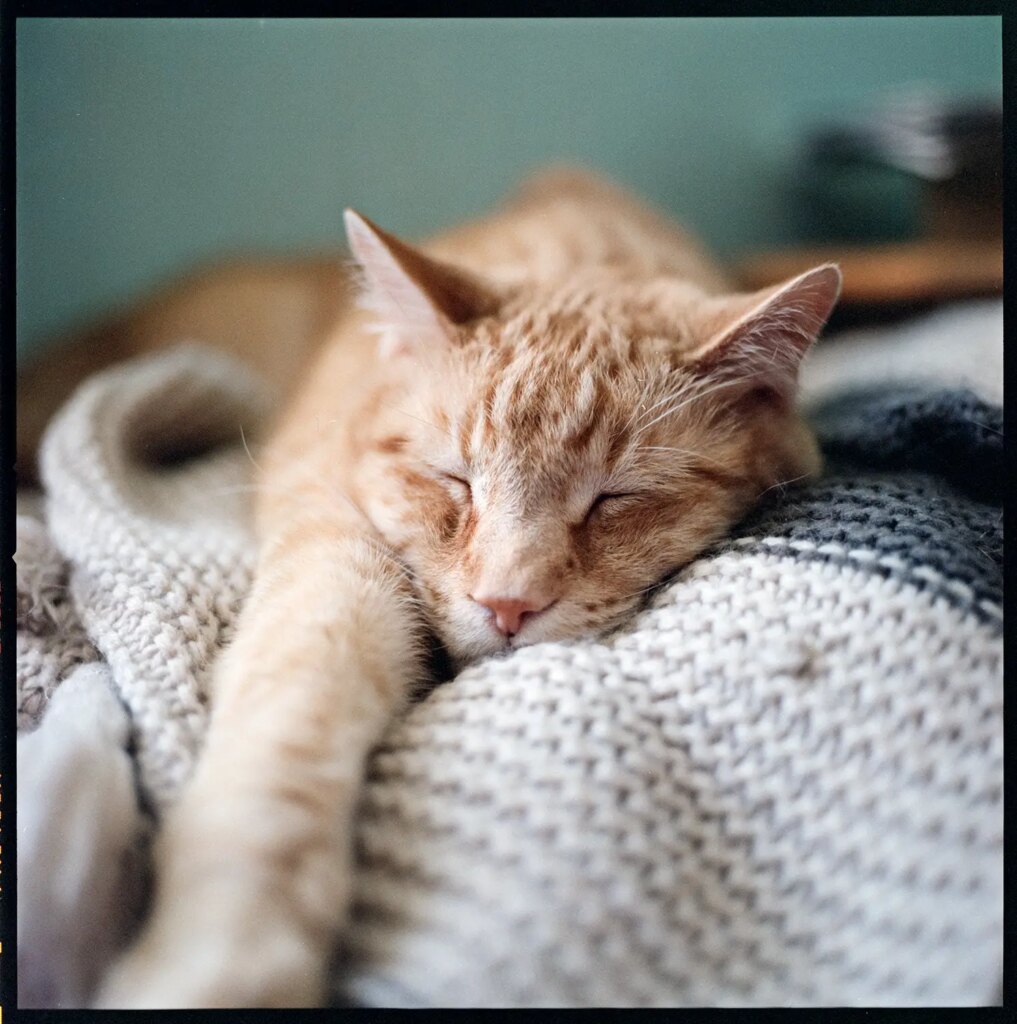
Lens: Zeiss Planar T* 80mm f2.8 C with 10mm extension tube
Film: Fuji 400H
Settings: 1/60th of a second, f2.8
Sounds and haptics of the Bronica S2a
If the tactile feel of a camera is important to you, the Bronica is solid and serious. The shutter sounds hefty, smooth, and rich. The pop-up finder and magnifier are a joy to use. The film back detaches by pushing the dark slide in and the action of this is very nice. Clicking it back onto the body is even better. Lenses attach and release with sturdy clicks. Focus is smooth. Turning the shutter speed selector feels… ok. Same with the lens apertures. Speeds and apertures are all in full stop clicks. The only haptic that I dislike is the advance knob. It takes a few cranks and gives some resistance when it’s hoisting those huge shutter curtains. Then it seems to stop and needs a bit of extra force to complete the action with a “did I just break it?” sounding CACK. I’ve been assured this is just how it sounds to cock the shutter on this camera.
Sounds and haptics of the Hasselblad 500c/m
One universal truth of the iconic cameras is that they feel and sound amazing. The 500c/m is no exception. Just about every possible action is very satisfying. When things unlock and lock, such as the film cartridge, lens, film back, or swapping knobs or finders, everything fits into place with a soft, confident click. The firing action is a loud but luxurious “clop-clop.” Winding will reset the mirror, cock the shutter, and advance the film all in exactly one full turn with a “zizizi-clip” that’s probably my favorite of all the actions on the camera. It might be my favorite camera sound, period. I use the crank style knob, which makes the wind one smooth action. Shutter and aperture are on the lens and they move with soft clicks. There are full stops for speed and half stops for aperture. Focus is smooth on the later CM lenses, just a touch stiff on the earlier C series, though this might just be the samples I’ve handled. If I had one word for the tactile experience of the 500c/m, it would be “precision.”
Reliability and known issues with the S2a
In short, the S2a feels indestructible. The Bronica S2a supposedly fixed some gear issues with earlier models to make a highly reliable camera even more reliable. Mine, which I bought as “mint,” did arrive with something slightly off in the shutter timing. I sent it for a full overhaul to Frank Marshman (aka Camera Wiz) who is a specialist in the Bronica lines. It seemed this wasn’t a common issue and he assured me after repair that “it should be good for another 40 years now.”
The only known problem with S2a’s that I’m aware of is related to the mirror foam. After decades, like so many other cameras, some of the foam used has begun to break down. The foam in question here is seated under the mirror and causes the mirror to sag just enough to affect the focus. Fixing means replacing the foam, which is a bit tricky if you don’t have ample patience and nimble fingers. I did mine prior to discovering that it needed a full service anyhow and I remember it being more trying than expected. While you’re at it, I recommend replacing the focusing screen with something brighter as the original is dim.
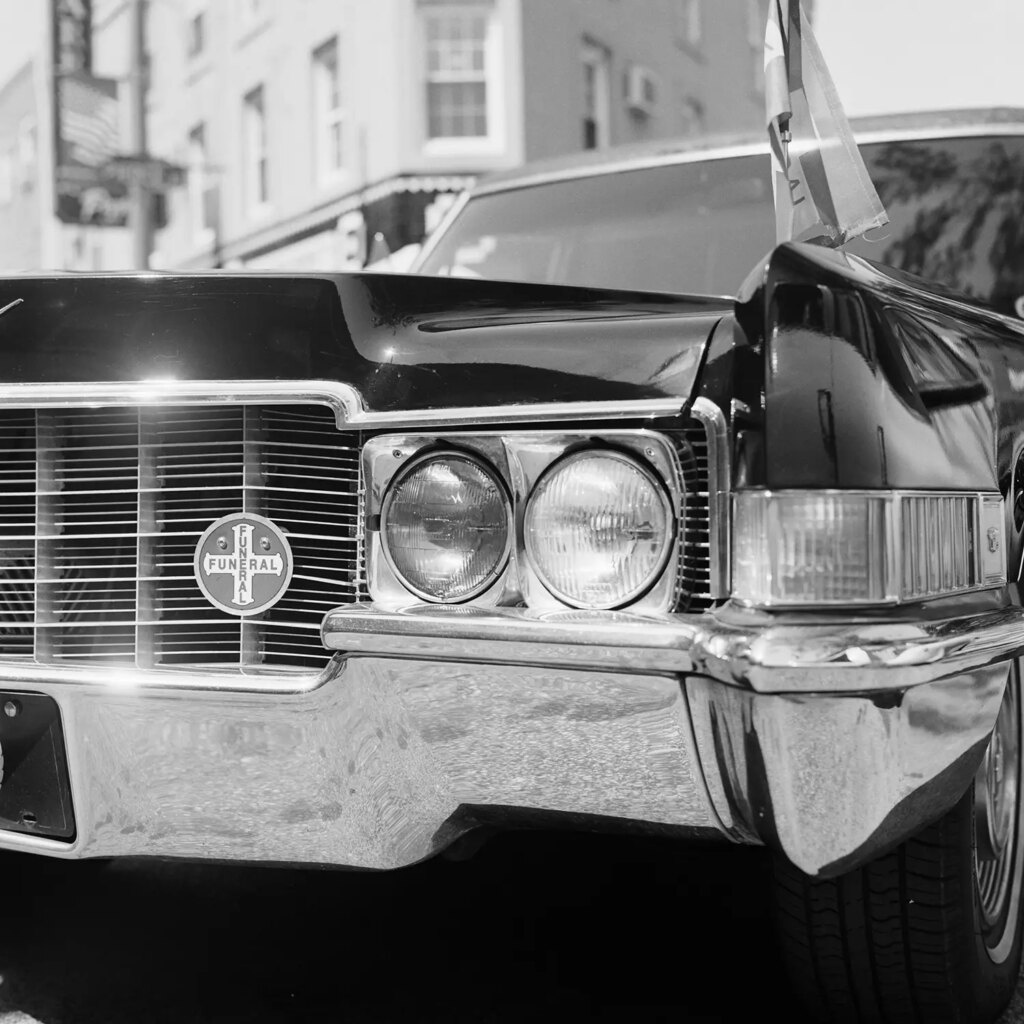
Lens: Nikkor H.C. 75mm f2.8
Film: Ilford Pan F+
Settings: 1/125th of a second, f8
Reliability and known issues with the 500c/m
The Hasselblad is a very particular machine, and demands that the user do certain things in certain ways. For example, the shutter must be cocked if you want to remove or mount a lens. Don’t try to remove the film back while the mirror lock-up is engaged. If you are using an extension tube, make sure to attach the tube to the body, then the lens, and remove in reverse order (lens, then tube). If you do anything that the Hasselblad does not like, it will let you know by locking up on you. Generally speaking, if something offers resistance, stop and check if you’re doing it wrong. Never force anything. Each lens contains a shutter mechanism, which means each lens might function differently in, say, cold weather. I’ve heard so many stories about “the Hasselblad unjamming tool” and recommended service every 1-3 years that suggest this machine is a bit more temperamental. That said, I haven’t encountered any serious problems.
While out shooting for this article, I did find my shutter inexplicably locked mid-roll. I tried to calmly trace the problem and finally found that the lens hadn’t been fully clicked into place. Unfortunately I forgot to recheck focus after correcting it and the shot was ruined. No big deal, but an example of how particular this system is about things being just as they should be.

Lens: Zeiss Sonnar T* 180mm f4 CF
Film: Kodak Ektar
Settings: 1/60th of a second, f11
The only common issue I know of is light leaks in the film backs, which is another case of inevitable material decay. This one is a simple DIY task with new seal kits on ebay for under $20. My only note here is that the kit I bought only replaced the mylar and foam, but didn’t address a thin light baffle opposite the foam. It took me awhile to understand why I was still getting occasional leaks until I discovered this and replaced it with new foam.
I have not had my Hasselblad serviced yet. Due to their popularity, it should be much easier to find a qualified Hasselblad tech and I believe Hasselblad still offers service on their old models.
Head to Head
I was mostly curious about handling in the field, so I packed both cameras plus a wide lens, a normal lens, and long lens for each into a very full backpack. All shots were tripod mounted using a cable release, trying to match focus as close as possible. Each camera was loaded with a roll of Ilford Delta 100 and the film was developed with HC-110 B all in one tank to keep development consistent. The images were all DSLR scanned with identical settings. The only digital processing was inverting and setting the black point.
While I’ve detailed all the ways in which these two systems differ, the shooting experience was enjoyable for both. In general, the Hasselblad does feel more elegant, if a bit more delicate, than the clever but brutish S2a. These are cameras I mostly shoot on a tripod, so the only major distinction was the lack of mirror lock-up on the Bronica. There’s just so much going on between the mirror and focal plane shutter movements, it causes the camera jiggle when it fires just enough to creates blur with some slow shutter speeds on longer lenses despite the use of a tripod and cable release. If I were shooting handheld, the bulk of the Bronica might have actually made it the more stable of the two, though I’d have been even more concerned about slow speeds. It doesn’t happen often, but I did lose one shot in this roll to vibrations. It happened to be the same shot that the Hasselblad briefly jammed on which caused me to miss focus. So probably that location was just cursed.
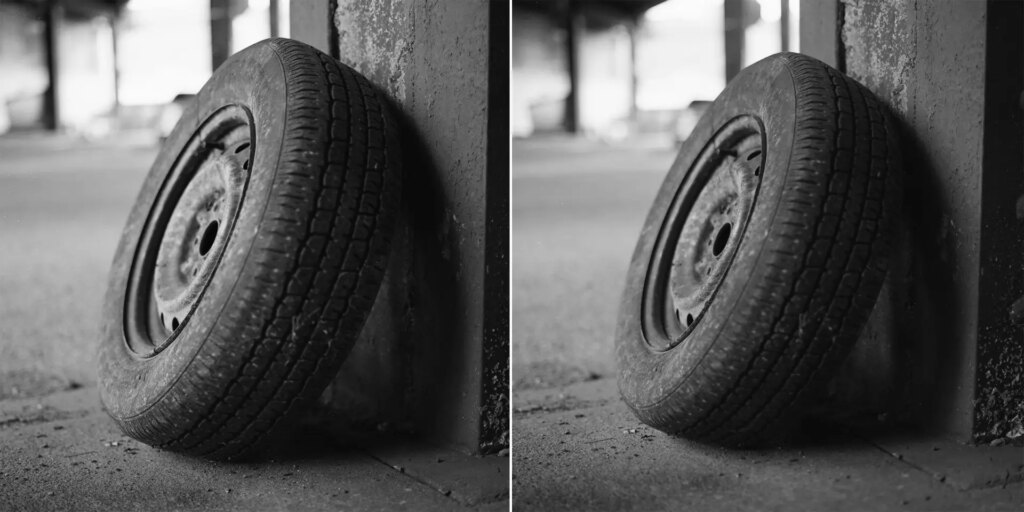
right: Nikkor H.C. 75mm f2.8 shot at f2.8, 1/60th of a second, 1.3 meters from subject
Focus was tricky to match on this one. I seem to have focused ever so slightly closer in the left hand image
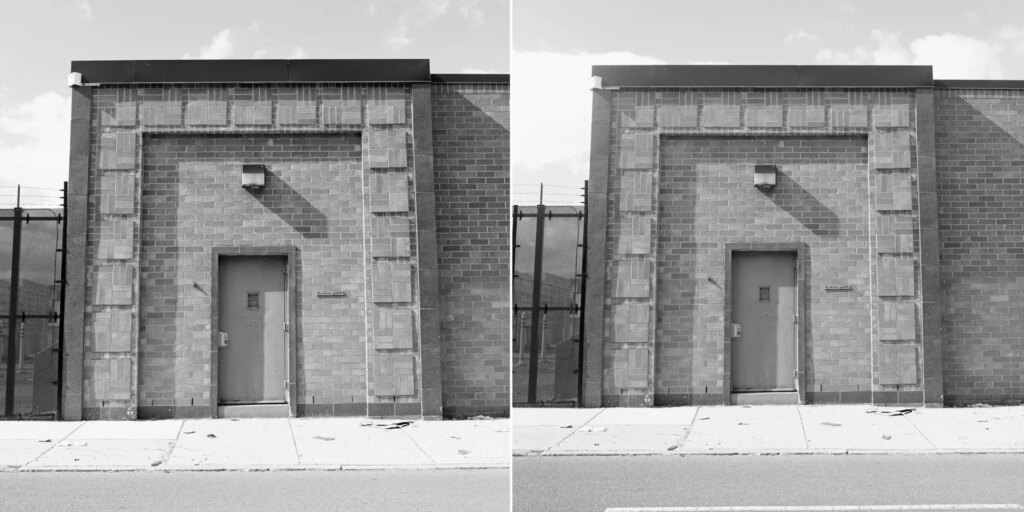
right: Nikkor H.C. 75mm f2.8 with circular polarizing filter. Shot at f11, 1/15th of a second, 10 meters from subject
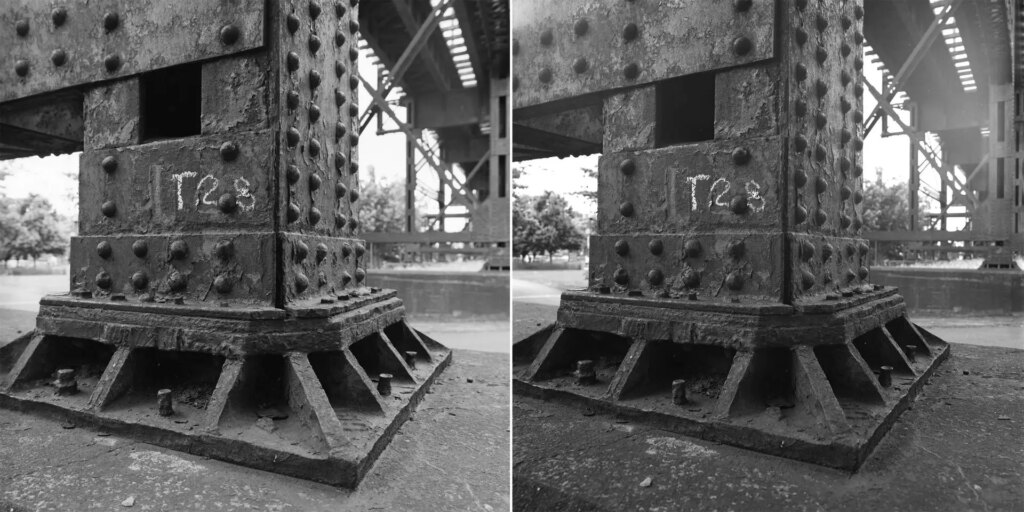
right: Zenzanon MC 50mm f2.8 shot at f11, 1/15th of a second, 1 meter from subject
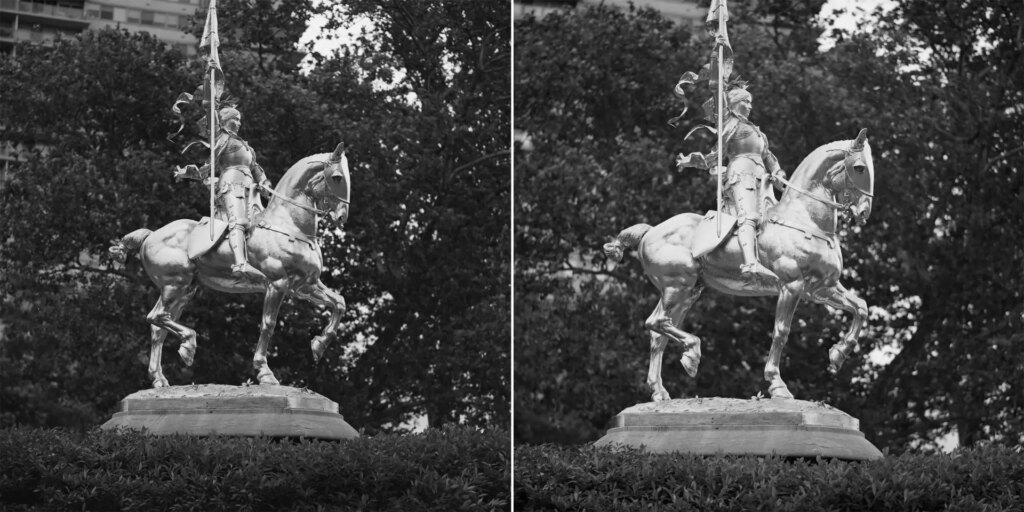
right: Nikkor P.C. 200mm f4 shot at f4, 1/500th of a second, 15 meters from subject
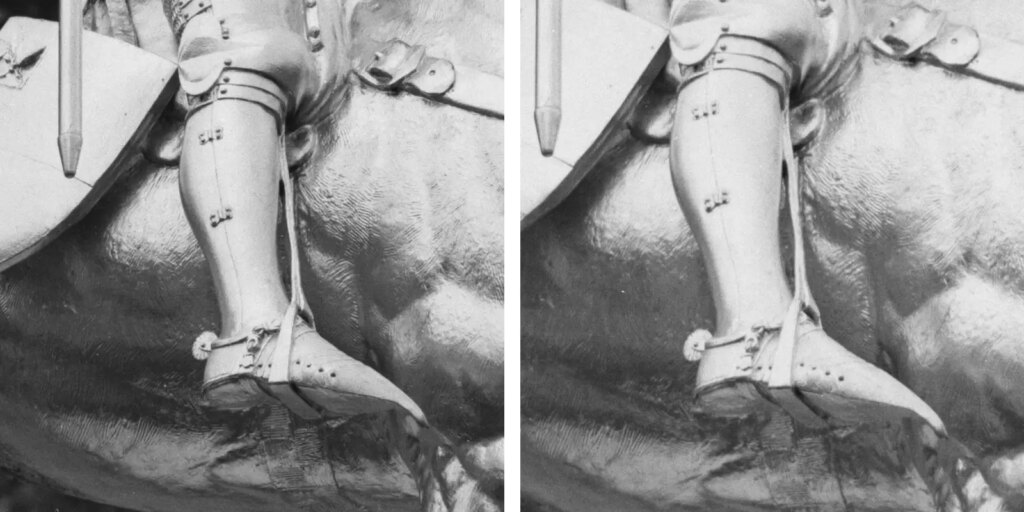
However important the user experience is, the images are what matters in the end. My guess was that final images would be very very close. Are they? I go back and forth. Initially they seemed dramatically different, then I looked again the next day and they felt remarkably similar. The most obvious difference at a glance is that the Zeiss lenses have stronger contrast, which is likely due to more sophisticated coatings*. My S2a lenses are all coated, but they have a more rounded rendering with increased flare and reduced contrast. This isn’t good or bad, just a particular look which might be suited to certain types of subjects. The Zeiss lenses also resolved finer details, though this is on close inspection and I wouldn’t complain with any of the Nikkor or Zenzanon images. I assumed, if there was a difference in quality, it would be most noticeable wide open. All lenses performed equally well wide open though, and the differences in character were just as apparent when stopped down to f11.
*my Zeiss lenses are all from the mid-90s, about 20 years after the S2a lenses were likely made.
The Question of Value
One subject which I haven’t really covered is price. As these were both discontinued decades ago, prices are going to fluctuate and so I can only look to general trends. There’s no surprise that Hasselblads, given their reputation and popularity, are more expensive and also easier to find. At the moment, it looks like a basic Hasselblad kit of body, lens, finder, and back is going to cost 4x-5x what an equivalent S2a kit would run. Just buying an Acute Matte D focusing screen for the 500c/m will cost more than an entire S2a. Lens prices vary more, but the difference is still significant. Because the S2a lenses are so stripped down, there’s also far more that can go wrong in a Zeiss lens which would make me more cautious about who I’m buying from. All that said, the Zeiss Planar T* 80mm f2.8 of any era is easily one of the most impressive lenses I’ve ever used and might warrant owning a Hasselblad all on its own. Then again, that Nikkor isn’t half bad and a whole lot more affordable.
The question of value is a personal one. I do not believe that the 500c/m is five times superior to the S2a in handling OR image quality. I actually find each one has its merits and both create excellent images of different character. I don’t know if the Hasselblad line is over-priced, but the Bronica certainly seems under-appreciated and a bargain by comparison.
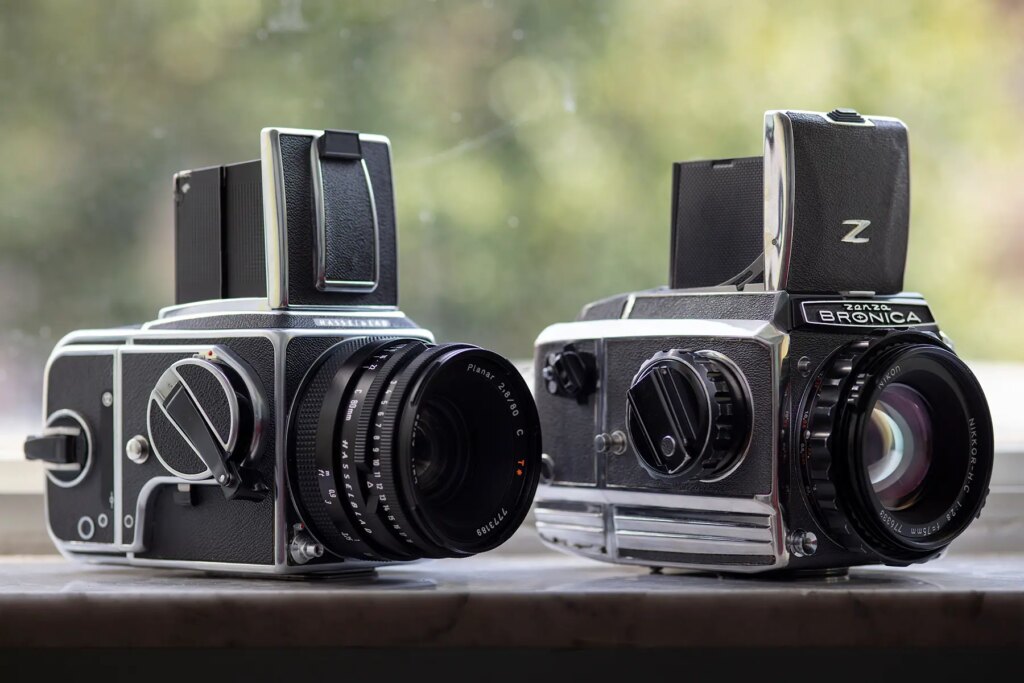
Right: Bronica S2a with WLF and Nikkor H.C. 75mm f2.8
If you’d like to read more about the S2a, I recommend this excellent dedicated review by Mark Herse here on 35mmc
Share this post:
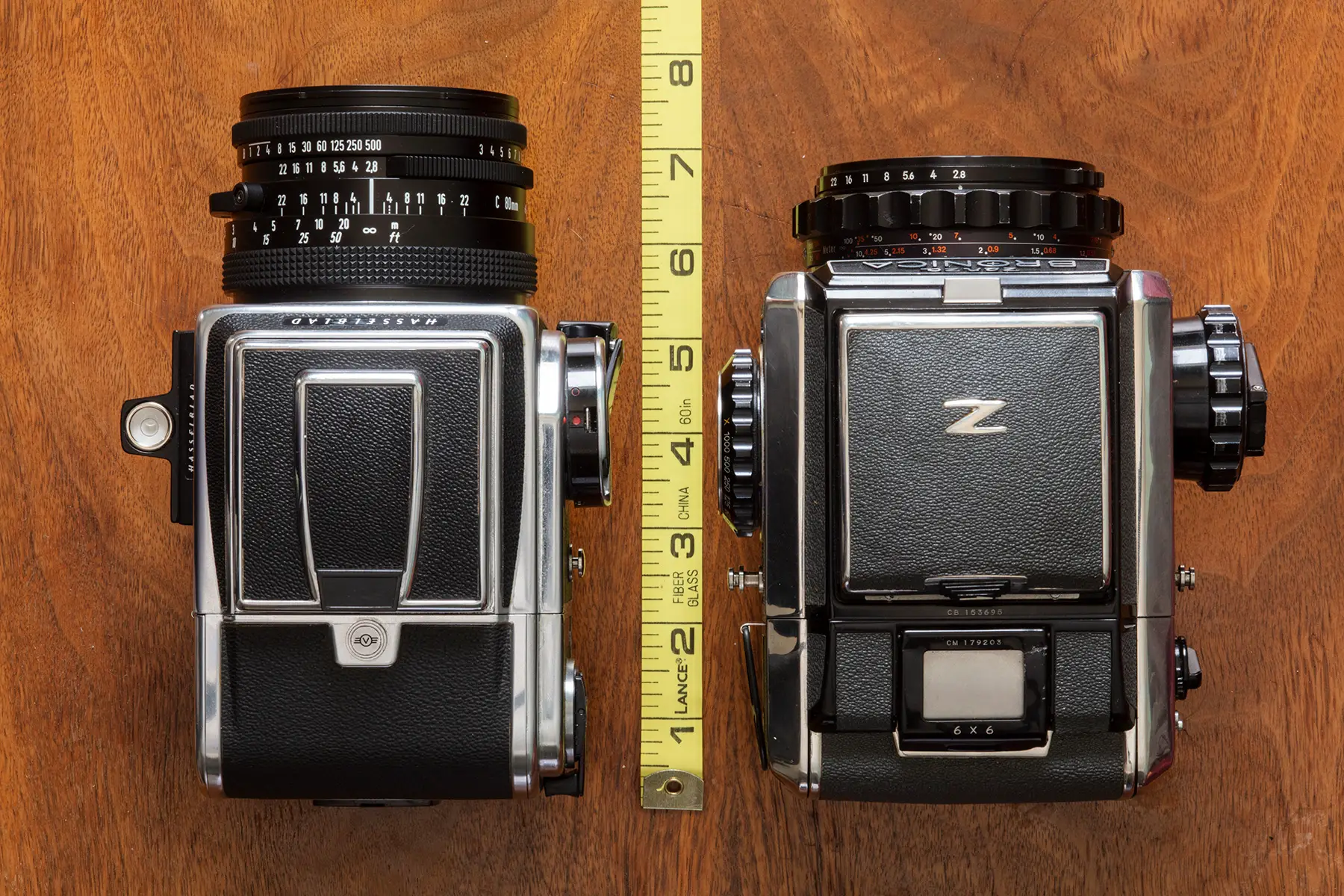








Comments
Kodachromeguy on Hasselblad and the Bronica – Comparing an Icon with a Forgotten Gem – By Dave Palumbo
Comment posted: 04/07/2022
Comment posted: 04/07/2022
Comment posted: 04/07/2022
CP93 on Hasselblad and the Bronica – Comparing an Icon with a Forgotten Gem – By Dave Palumbo
Comment posted: 04/07/2022
When I was shopping for a 6x6 in the 90s, I rented both a 500 CM and an SQ-Ai. To my eye, the Zenza lenses had better contrast and color rendition, so that's what I bought -- still have it, too, though lugging it around is harder on my old back these days.
Your mileage, as they say, may vary.
Comment posted: 04/07/2022
Comment posted: 04/07/2022
Comment posted: 04/07/2022
Kurt Ingham on Hasselblad and the Bronica – Comparing an Icon with a Forgotten Gem – By Dave Palumbo
Comment posted: 04/07/2022
Comment posted: 04/07/2022
Vlad Serebryany on Hasselblad and the Bronica – Comparing an Icon with a Forgotten Gem – By Dave Palumbo
Comment posted: 04/07/2022
Comment posted: 04/07/2022
Matthew Bigwood on Hasselblad and the Bronica – Comparing an Icon with a Forgotten Gem – By Dave Palumbo
Comment posted: 04/07/2022
Victor on Hasselblad and the Bronica – Comparing an Icon with a Forgotten Gem – By Dave Palumbo
Comment posted: 04/07/2022
AlistairH on Hasselblad and the Bronica – Comparing an Icon with a Forgotten Gem – By Dave Palumbo
Comment posted: 04/07/2022
The tonal gradation is way better in all of the Zeiss images - just look at how much more can be seen in the tyre tread with the Zeiss! The statue has lots more tonal nuance with the Zeiss and with the industrial riveted image, there is just a lot of ghosting flare with the Nikkor.
It is strange - I normally read camera and lens comparisons, and hardly see any difference, while the writer sees a lot. In this case, it is the other way round - the writer does not see much, but to my eye, the Hasselblad/Zeiss combination is vastly better then the Bronica/Nikkor.
I am going to buy a 6x6 soon, and was unsure between a 'Blad and a Bronical SQ. Having seen this article, I am definitely going for the Hasselblad!
Brilliant article - many thanks!
Comment posted: 04/07/2022
Comment posted: 04/07/2022
AlistairH on Hasselblad and the Bronica – Comparing an Icon with a Forgotten Gem – By Dave Palumbo
Comment posted: 04/07/2022
In my Scottish schooling in the 1960s and 70s we were absolutely banned from using the old-fashioned measures (even saying a foot or inch out loud would get a telling-off from the teacher), and I have never really understood them to this day! I was amazed when I came to England in the '80s and found that even young people were talking using feet, pounds, stones etc. - a completely alien world to me.
Comment posted: 04/07/2022
Johan on Hasselblad and the Bronica – Comparing an Icon with a Forgotten Gem – By Dave Palumbo
Comment posted: 05/07/2022
Okiman on Hasselblad and the Bronica – Comparing an Icon with a Forgotten Gem – By Dave Palumbo
Comment posted: 05/07/2022
Comment posted: 05/07/2022
Comment posted: 05/07/2022
Comment posted: 05/07/2022
Joe on Hasselblad and the Bronica – Comparing an Icon with a Forgotten Gem – By Dave Palumbo
Comment posted: 05/07/2022
jason gold on Hasselblad and the Bronica – Comparing an Icon with a Forgotten Gem – By Dave Palumbo
Comment posted: 06/07/2022
Hasselblad were my dream camera till I was told to use them on shoots ! I couldn't focus them. My eyesight! I did indeed go medium format for Fashion, Industrial and Advertising. I used Mamiya C- series. Yes the Twin lens.
Later I traded to Pentax 6x7. It simply was too Big, too Heavy but results spectacular.
The kit was traded at Samy's LA for a new Leica M6. In a few weeks I had exposed more frames in Leica than 20 years with Pentax 6x7.
Eugen Mezei on Hasselblad and the Bronica – Comparing an Icon with a Forgotten Gem – By Dave Palumbo
Comment posted: 11/07/2022
But: "My S2a lenses are all coated, but they have a more rounded rendering with increased flare and reduced contrast. This isn’t good or bad, just a particular look which might be suited to certain types of subjects."
Ofcourse it is bad. Why would lens producers invest millions in resarch and engineering of coatins if reduced contrast is as good too?
The question is, did you use lensshades?
Resolution (and contrast) are vastly superior with your Zeiss lens. Not that the Nikkors would be bad, but in direct comparison the difference is noticeable.
Comment posted: 11/07/2022
Comment posted: 11/07/2022
Comment posted: 11/07/2022
Tim on Hasselblad and the Bronica – Comparing an Icon with a Forgotten Gem – By Dave Palumbo
Comment posted: 21/07/2022
I love this system. Even you see one...absolutelt get it. It will appreciate in the years to come.
cmf on Hasselblad and the Bronica – Comparing an Icon with a Forgotten Gem – By Dave Palumbo
Comment posted: 24/09/2022
Comment posted: 24/09/2022